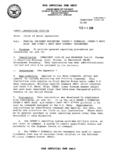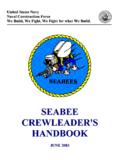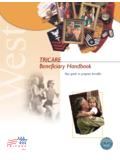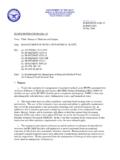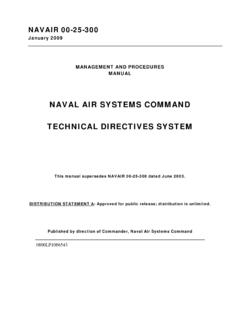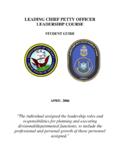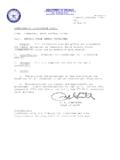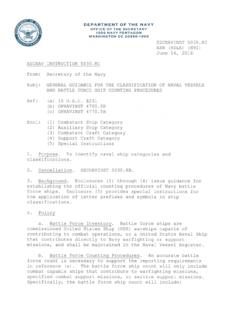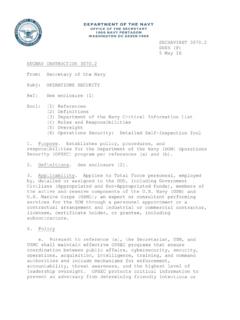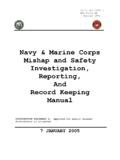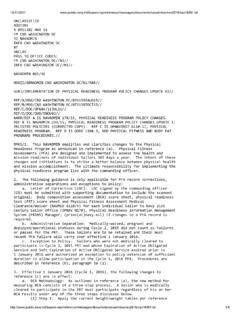Transcription of 28 Jan 09 - NAVY BMR
1 DEPARTMENT OF THE NAVY. OFFICE OF THE chief OF naval operations . 2000 NAVY PENTAGON. washington , 20350-2000. IN REPLY REFER TO. OPNAVINST N4. 28 jan 09 . OPNAV INSTRUCTION From: chief of naval operations Subj: NAVY PHYSICAL SECURITY AND LAW ENFORCEMENT PROGRAM. Ref: See Appendix C to Enclosure (1). Encl: (1) Navy Physical Security and Law Enforcement Program Requirements 1. Purpose. The intent of this instruction is to identify responsibilities and provide guidance for the protection of people and assets throughout the Navy as directed in references (al through (el. This instruction is a complete revision and must be reviewed in its entirety. 2. Cancellation. OPNAVINST and OPNAVINST 3.))
2 Background a. Three core lines of effort are necessary for protection: critical infrastructure protection, continuity of operations and Force Protection (FP). Antiterrorism (AT), Law Enforcement (LE). and Physical Security (PS) are pillars which complement, integrate with, and support the core lines of effort. While the prioritization of implementing the pillars must be based on each commander's risk management process, in general, the AT mission shall be treated as the effort of first importance as it ensures the availability of Navy assets for war-fighting missions. b. Reference (a) provides over-arching Navy policy, guidance, information, procedures and responsibilities for the AT line of effort.
3 Enclosure (1) to this instruction provides security and LE policy for safeguarding personnel, property, and material and enforcing rules and regulations at Navy installations, activities, and afloat/operational commands. Security measures that will deter, detect, delay, and defend against terrorist attack are addressed. OPNAVINST 28 jan 09 . c. The policy framework in this instruction dictates man, train, and equip models and sets the operational posture for the Navy's program. d. As the Navy's program adjusts and transforms over the near term, commanders must make every effort to rapidly conform to these new guidelines and eliminate duplicative efforts, wasteful or convenience behaviors that do not directly contribute to our security posture or align with directed priorities.
4 E. For the purpose of brevity in this instruction only, the short title for the Navy PS and LE Program will be "Navy Security Program.". 4. Applicability a. This instruction applies to all Navy military personnel, civilian employees, contractors, facilities, ships, aircraft, and non-Navy organizations physically located on or aligned to Navy-controlled installations worldwide. b. Where this instruction conflicts with the Geographic Combatant Commander (GCC) PS or LE requirements, the GCC's requirements take precedence. Deviation from the policy and standards in this instruction must be documented in the appropriate planning and implementing guidance ( , protection plans, command guidance, etc.)
5 Specific waiver/exceptions are not required, however the cognizant Navy Component Commander (NCC) will notify Deputy chief of naval operations for Fleet Readiness and Logistics (CNO (N4)), in writing, of any deviation from Office of the chief of naval operations (OPNAV) policy necessary to meet GCC requirements. 5. Exceptions. Navy Nuclear Security ( , weapons, naval Nuclear propulsion Program, and special nuclear material) , Department of Defense high risk billet programs, personnel security program (security clearances, etc.), information systems and network security, industrial security or chemical agent security requirements and policy are addressed by the following instructions: a.
6 Reference (f) provides specific policy, planning guidance and requirements for Navy Security Force (NSF). 2. OPNAVINST 28 jan 09 . personnel, Harbor Security Boats (HSBs), and security-related equipment for waterfront restricted areas and nuclear weapons limited areas. The Strategic Weapons Facility (SWF) Commanding Officers (COs) have operational and tactical control of these security forces and patrol boats. Reference (g) provides guidance for the safeguarding of nuclear reactors and special nuclear material. b. References (h) and (i) provide specific policy and guidelines for the Department of the Navy Information Systems and Security Programs. c. Reference (j) establishes standards and guidance for personnel access to classified information and assignment to sensitive duties consistent with the interests of national security.
7 D. Reference (k) provides standards and responsibilities for safeguarding chemical agents. 6. Policy a. The primary objective of the Navy Security Program is to safeguard personnel, property, facilities and materiel and to enforce laws, rules, and regulations at Navy installations, activities, and operational commands. Capability requirements and resourcing levels will be established using the approved Required Operational Capability (ROC) tiered methodology contained in reference (1). Figure 1-1 identifies the baseline security requirements for shore installations based on ROC. levels. FIGURE 1-1. ROC Baseline Functions ROC Baseline Functions*. ROC 1: Access control, mobile patrols, Intruder Detection System (IDS) , Military Working Dog (MWD) teams, armed response teams, and all requirements mandated in NSPS-28, Nuclear Weapons Security Manual ( ), and SECNAVINST , as applicable.
8 ROC 2: Access control, external Entry Control Points (ECPs) , water barriers, HSBs, MWD teams, mobile patrols with back-up capabili ty, ability to respond to simultaneous events, and internal ECPs. 3. OPNAVINST 28 jan 09 . ROC 3 : Access control, external ECPs, mobile patrols with back-up capability, and ability to respond to a single event. (Patrol/response may be provided by nearby installation as directed by the region commander.). ROC 4 : Access control (may be automated) and mobile patrol (may be provided by nearby installation/local LE as directed by the. region commander.). ALL: LE response capability with the ability to respond within - - 15 minutes. (This capability may be provided by a nearby local LE as directed by the region commander.)
9 Emergent, life-threatening calls require an immediate response, with due regard for safety and traffic conditions. *Note: Specific security requirements will be based on type of assets assigned/supported b. Operational commanders, region commanders, fleet commanders, Installation Commanding Officers (ICOs), and organizational COs shall implement this tiered approach to security capabilities and resources in reference (1) and this instruction. c. ICOs shall establish and maintain a Navy Security Program that implements higher headquarters guidance and plans. Command and installation protection plans shall include all aspects of the protection framework, including ,PS, AT, and LE.
10 Elements, as a part of an integrated family of capabilities. d. COs shall use approved Navy Tactics, Techniques and Procedures (NTTPs) and Navy Tactical Reference Publications (NTRPs) ( , references (m), (n), and (0)) to carry out requirements set forth in this instruction. Any variance from the guidance and procedures outlined in appropriate NTTPs and NTRPs will be documented in local plans and instructions signed by the CO. 7. Roles and Responsibilities a. Deputy chief of naval operations for operations , Plans and Strategy (CNO (N3/N5)) provides overarching AT policy'and strategic oversight of the Navy Security Program and will annually assess the effectiveness of current policies and standards.
